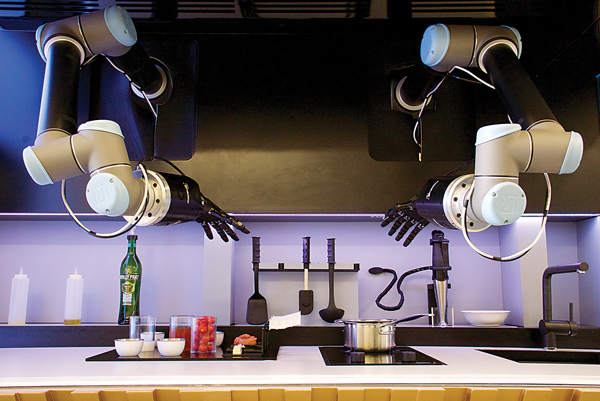Kitchen robotics; Concentration technology for milk; GM citrus trees
CUTTING EDGE TECHNOLOGY
 Robotic kitchen can emulate cooking skills of master chef
Robotic kitchen can emulate cooking skills of master chef
Moley Robotics, London, UK, plans to introduce a robotic kitchen for home use in 2017 with an iTunes’ style library of recipes. The kitchen and its anticipated $75,000 price tag will be comprised of four integrated major kitchen components—robotic arms and hands, oven, stovetop, and touchscreen unit. Consumers can operate the kitchen via touchscreen control or remotely via smartphone. Under the latter scenario, users can program their Jetson-style kitchen at work and arrive home to a freshly prepared meal. Glass screens enclose the unit when it’s in use for safe operation. When not in use, the robotic arms retract from view.
The robotic arms and hands work by emulating the movements of a chef or cook. At a demonstration of the robotic kitchen at the 2015 International CES Asia event in Shanghai, China, the robot copied the preparation and cooking techniques of 2011 BBC master chef Tim Anderson, who had been filmed by 3D motion capture technology while wearing special gloves. The recorded data were then inputted into the robot’s controls.
Concentration technology produces shelf-stable milk
Concentration technology developed by Charles (Chuck) Sizer and Dairyvative Technologies, Markesan, WI, removes up to 95% of the water from pasteurized milk, resulting in a lactose-free milk concentrate with the viscosity of honey. The pumpable product can be packaged in aseptic containers—from 5 gal to 20 tons—and has a 6 mo shelf life.
The technology, dubbed SEVENx, is based on evaporation and hydrolyzation of the lactose into its constituent sugars—glucose and galactose. The final concentrated product is 17% of its original volume and retains protein and nutrients. When reconstituted with water, the product has a taste profile similar to chilled milk at the grocery store. One 5-gal bag can yield more than 300 8-oz servings of milk. The concentrated product can also be used to produce dairy products such as yogurt and cheese as well as an ingredient in other applications.
In July 2015, Dairyvative Technologies partnered with Cornelius, Inc., a manufacturer of beverage dispensing systems, to offer concentrated milk dispensing to beverage brand owners and foodservice retailers. Using Cornelius’ technology, the dispenser allows consumers to flavor their milk. Cornelius’ technology also enables the milk to be carbonated during dispense. “We are pleased to have the opportunity of working with Cornelius to introduce a new environmentally sustainable technology that will revolutionize the way milk is distributed and consumed. People worldwide will enjoy the fresh-tasting milk made possible by this process,” said Chuck Sizer, founder and CEO of Dairyvative Technologies.
GM enhances resistance to citrus greening
Univ. of Florida researchers have developed genetically modified citrus trees that show enhanced resistance to greening, and have the potential to resist canker and black spot as well. However, the commercial availability of the new trees is still several years away.
The researchers used a gene isolated from the Arabidopsis plant, a member of the mustard family, to create the new trees. Their experiment resulted in trees that exhibited enhanced resistance to greening and reduced disease severity. Several trees remained disease-free after 36 months of planting in a field with a high number of diseased trees. The journal PLOS ONE recently published a paper on their study.
Citrus crop improvement using conventional breeding methods is difficult and time consuming due to the long juvenile phase in citrus, which can vary from four to twelve years. Improvement of citrus through genetic engineering remains the fastest method for improvement of existing citrus cultivars and has been a key component in the Univ. of Florida’s genetic improvement strategy.
Citrus greening threatens to destroy Florida’s $10.7 billion citrus industry. The diseased bacterium first enters the tree via the tiny Asian citrus psyllid, which sucks on leaf sap and leaves behind the greening bacteria. The bacteria then move through the tree via the phloem—the veins of the tree. The disease starves the tree of nutrients, damages its roots, and the tree produces fruits that are green and misshapen, unsuitable for sale as fresh fruit or, for the most part, juice. Most infected trees eventually die and the disease has already affected millions of citrus trees in North America.
Citrus greening was first detected in Florida in 2005. Florida has lost approximately 100,000 citrus acres and $3.6 billion in revenues since 2007, according to researchers.
If you are working on or know of some cutting edge technology that you would like to be featured in this column, please send an email to [email protected].
